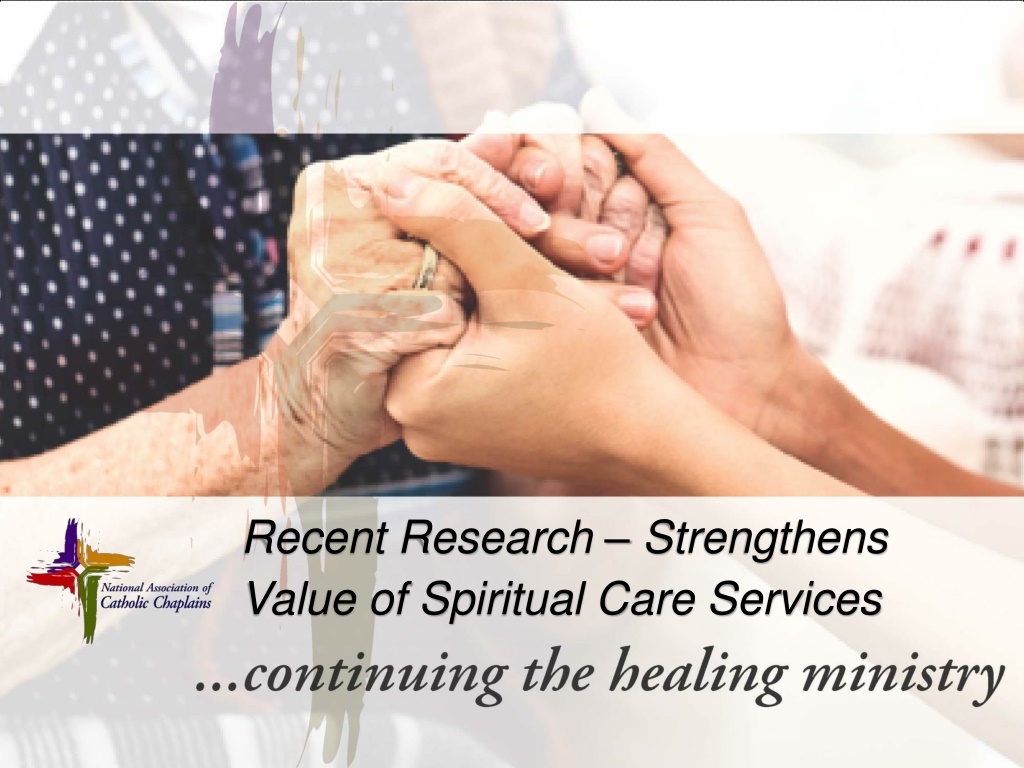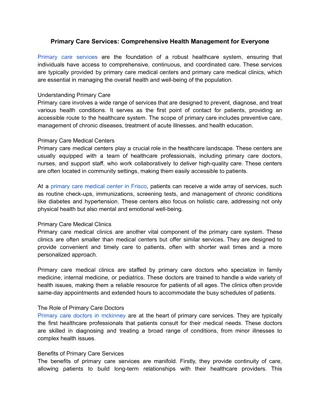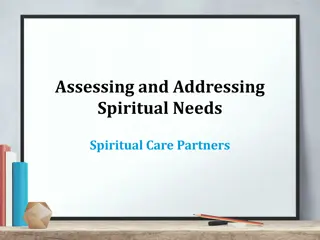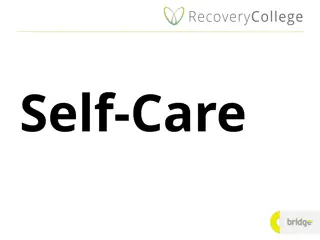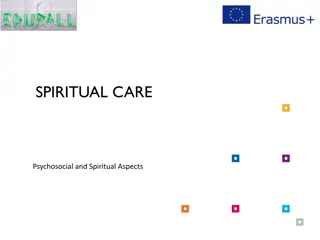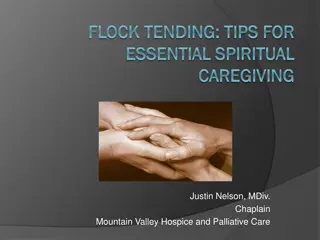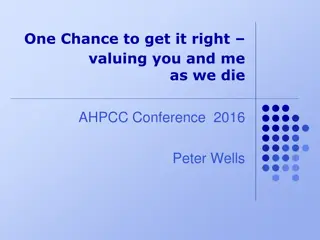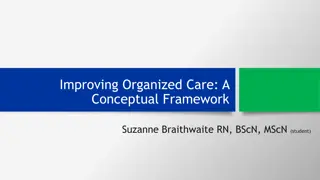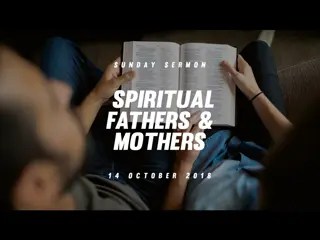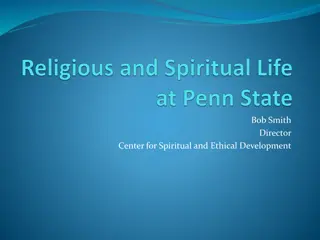Strengthening Value of Spiritual Care Services Through Recent Research
Recent research emphasizes the importance of spiritual care services, highlighting collaborative efforts, evidence-based approaches, and strategic partnerships in the field. Initiatives focus on research efficacy, quality of care, and outcomes measurement, aiming to enhance patient experience and clinical quality while addressing spiritual needs. Organizations like Transforming Chaplaincy and the Joint Research Council play pivotal roles in advancing research literacy and advocacy in spiritual care.
Download Presentation

Please find below an Image/Link to download the presentation.
The content on the website is provided AS IS for your information and personal use only. It may not be sold, licensed, or shared on other websites without obtaining consent from the author. Download presentation by click this link. If you encounter any issues during the download, it is possible that the publisher has removed the file from their server.
E N D
Presentation Transcript
Recent Research Strengthens Value of Spiritual Care Services
Objectives: o Provide background on collaborative research efforts o Offer recent research as examples o Discuss the implications for making case for spiritual care
Strategic Partners Key Initiative - Research Work on evidence-based efficacy Productivity? What is being done by chaplains? Quality? Is what being done contributing to overall patient quality and satisfaction? Effectiveness? Is what is being done effective? Impact? Can one identify and measure the outcomes of spiritual care?
Use evidence-based approaches to ministry o What we are doing? o Why we are doing it? o How contributes to outcomes for recipient? o Has intervention Addressed spiritual need? Reduced distress?
Strategic Partners Key Initiative Research Name Benefits Describe ministry in benefit language We can help you . o Increase patient experience/satisfaction o Increase employee engagement/retention o Increase physician satisfaction o Enhance clinical quality o Reduce readmissions/burdensome treatments Clarify desired course/treatments http://www.nacc.org/resources/career/default.aspx#elevatorspeeches
Transforming Chaplaincy https://www.transformchaplaincy.org/ Fellowships o CPE Research Education Program grants o E-Learning Module - Online Continuing Education sessions, Religion, Spirituality and Health: An Introduction to Research, as a way to build evidence- based chaplaincy care. o
Joint Research Council o Enhancing communication among colleagues research- related educational opportunities/resources o Collaborating in advocating for research efforts and research literacy o Providing a central place to identify/disseminate info
Association for Clinical Pastoral Education (USA) Association of Professional Chaplains (USA) Canadian Association for Spiritual Care (Canada) College of Health Care Chaplains (UK) Dutch Association of Spiritual Caregivers (Netherlands) European Network of Health Care Chaplaincy (Europe) Health Care Chaplaincy Network (USA) National Association of Catholic Chaplains (USA) Neshama: Association of Jewish Chaplains (USA) 10. New Zealand Healthcare Chaplains Association (New Zealand) 11. Pediatric Chaplains Network (USA) 12. Professional Chaplaincy Advisors England (England) 13. Chaplains associated with the former Scottish Association of Chaplains in Health Care (Scotland) 14. Spiritual Care Australia (Australia) 1. 2. 3. 4. 5. 6. 7. 8. 9.
2011 SCC beginning 2015 Standards of Practice o Standard 12, Research: The chaplain remains informed of relevant developments in evidenced-based and best practices in chaplaincy care through reading and reflecting on the current research and professional practice; and, where practical, collaborates or provides leadership on research studies. 2016 Revised Qualifications and Competencies
Integration of Theory and Practice Competencies 302. ITP6: Articulate how primary research and research literature inform the profession of chaplaincy and one s spiritual care practice. (ACPE Outcome 311.6)
Spiritual care providers integrate research literacy and may conduct research to ensure that their spiritual care is current and innovative in their practice. o Demonstrate through examples how you are utilizing current research literature in your spiritual care practice and work with interdisciplinary team members. o If applicable, what primary research have you participated in and what were the key findings? o How are you integrating your findings in your spiritual care practice?
How consistently to measure success? o Transforming Chaplaincy E-learning module with assess. o Assessment summary of key article (have several key ones available for accessibility Use template guide similar to the Rush template A research study that informed an approach to a clinical encounter, and show in verbatim how so In competencies narrative show read, reflected, integrated How the research has informed the chaplain s clinical practice (and how the chaplain s experience might enhance or challenge the research) How the candidate has presented the paper(s) to an interdisciplinary group and any outcomes of that presentation. Challenges Interviewers preparedness or pool of research proficient colleagues Evaluation of the applicability
Examples of Recent Research Recent Progress in Chaplaincy-Related Research, George Fitchett, Journal of Pastoral Care & Counseling, 2017, Vol. 71(3) 163 175. 2010 Over 1500 respondents, Mayo Clinic on patient expectations of chaplains o 78% Remind me of God s care and presence o 71% Offer support to family and friends o 69% Be with me in times of particular anxiety or uncertainty o 62% Prayer and/or read scripture/sacred texts o 39% Counsel me regarding moral/ethical concerns or decisions o 70% Wanted at least one chaplain visit Piderman, K.M., Marek, D.V., Jenkins, S.M., Johnson, M.E., Buryska, J.F., Shanafelt, T.D., Mueller, P.S. (2010). Predicting patients expectations of hospital chaplains: a multisite survey. Mayo Clinic Proceedings 85(1), 1002-1010. doi: 10.4065/mcp.2010.0168
Examples of Recent Research Spiritual screening models for non-chaplain usage Several models, with tests on validity and usefulness Recent study (2016) limitations in 5 different approaches, and recommended the simultaneous use of meaning/joy and self- described struggle items among cancer survivors is currently the best choice to briefly screen for R/S distress. King, S.D., Fitchett, G., Murphy, P.E., Pargament, K.I., Harrison, D.A., & Loggers, E.T. (2016). Determining best methods to screen for religious/spiritual distress. Supportive Care in Cancer. doi: 10.1007/s00520-016-3425-6 [Epub ahead of print] A recent study has also reported limitations in the popular Rush Screening Protocol. Fitchett, G., Murphy, P., & King, S. D. (2017). Examining the validity of the Rush Protocol to screen for religious/spiritual struggle. Journal of Health Care Chaplaincy. doi: 10.1080/08854726.2017.1294861. [Epub ahead of print]
Examples of Recent Research Religion and/or spirituality - one of most important resources to which people turn in face of serious illness 2013 - 8,405 cancer survivors - 65%-88% responded quite a bit or very much . My faith or spirituality has helped me through my cancer experience. Canada, A.L., Fitchett, G., Murphy, P.E., Stein, K., Portier, K., Crammer, C., & Peterman, A.H. (2013). Racial/ethnic differences in spiritual well-being among cancer survivors. Journal of Behavioral Medicine 36(5), 441-453. doi:10.1007/s10865-012-9439-8 2005 - 700+ newly diagnosed cancer patients in chemotherapy or radiation 77% use of prayer 19% use of spiritual healing Yates, J.S., Mustian, K.M., Morrow, G.R., Gillies, L.J., Padmanaban, D., Atkins, J.N., Colman, L.K. (2005). Prevalence of complementary and alternative medicine use in cancer patients during treatment. Supportive Care in Cancer 13(10),806-811. doi: 10.1007/s00520-004-0770-7
Examples of Recent Research 2001 - 406 persons with persistent mental illness 80% religious beliefs and practices helped them cope with symptoms/ frustrations 59% using prayer to cope with illness Tepper, L., Rogers, S.A., Coleman, E.M., & Malony, H.N. (2001) The prevalence of religious coping among persons with persistent mental illness. Psychiatric Services 52(5), 660-665. doi: 10.1176/appi.ps.52.5.660 Religious Coping Kenneth Pargament R/S coping - religious struggle (abandoned or punished by God, alienated from one s religious fellowship, doubts of faith) 50% of all patients may experience some R/S struggle 10% or more may experience moderate/ severe Compromises their health and well-being Pargament, K.I. (1997). The Psychology of Religion and Coping: Theory, Research, Practice. New York: The Guilford Press.
Examples of Recent Research Considerable body of evidence described adverse physical and emotional effects of R/S struggle. R/S struggle or R/S distress measures provides way to estimate: The acuity of R/S need in different groups of patients Level of chaplaincy staffing needed to address it Among medical rehabilitation patients Poorer rehabilitation outcomes Fitchett, G., Rybarczyk, B. D., DeMarco, G. A., & Nicholas, J. J. (1999). The role of religion in medical rehabilitation outcomes: A longitudinal study. Rehabilitation Psychology 44(4), 333-353. doi: 10.1037/0090-5550.44.4.333
Examples of Recent Research Among older medical patients More functional limitations Greater depressive symptoms Poorer quality of life Pargament, K. I., Koenig, H. G., Tarakeshwar, N., & Hahn, J. (2004). Religious coping methods as predictors of psychological, physical and spiritual outcomes among medically ill elderly patients: a two-year longitudinal study. Journal of Health Psychology 9(6), 713-730. doi: 10.1177/1359105304045366 Increased mortality Pargament, K.I., Koenig, H.G., Tarakeshwar, N., & Hahn, J. (2001). Religious Struggle as a Predictor of Mortality among Medically Ill Elderly Patients: A Two-Year Longitudinal Study. Archives of Internal Medicine 161, 1881- 1885. doi:10.1001/archinte.161.15.1881
Examples of Recent Research Consistent Findings - SC associated with higher levels of patient/ family satisfaction, not just chaplaincy care 2004, 1,440 patients at 14 different U.S. hospitals - one of the largest studies Greater satisfaction with chaplain care was associated with greater satisfaction with the overall hospital stay. Patients often reported that visits from the chaplain contributed to: Readiness to return home A faster recovery An easier hospitalization. Many patients reported chaplains helped them: Cope Feel more hopeful Find the strength to go on Item that received the highest score was The chaplain helped me realize that God cares for me. VandeCreek, L. (2004). How satisfied are patients with the ministry of chaplains? Journal of Pastoral Care and Counseling 58(4), 335-42. doi: 10.1177/154230500405800406
Examples of Recent Research Higher levels of patient/family satisfaction 2009, 250 patients in NYC orthopedic hospital 80% of patients w/ spiritual or religious needs reported Chaplain met these needs very well Most patients felt the chaplain made their stay easier and helped them tap into inner strengths and resources. Flannelly, K.J., Oettinger, M., Galek, K., Braun-Storck, A., & Kreger R. (2009). The correlates of chaplains' effectiveness in meeting the spiritual/religious and emotional needs of patients. Journal of Pastoral Care and Counseling 63(1-2),9-1-15. Retrieved from http://healthcarechaplaincy.org/userimages/Research/published_articles/Correlates%20of%20Chaplain%20Effec tiveness.pdf
Examples of Recent Research Higher levels of patient/family satisfaction 2011 - 3,000 general medical patients at UCMC 41% wished to discuss their religious or spiritual concerns during hospitalization 51% of those reported having such a discussion 61% of those discussions were with a chaplain If had a discussion about special concerns then: 60% more like to rate overall care as excellent 40% more likely to say they were extremely satisfied with the care from their physicians 70% more likely to report always having confidence and trust in their physicians 120% more likely to report excellent Williams, J.A., Meltzer, D., Arora, V., Chung, G., & Curlin, F.A. (2011). Attention to inpatients' religious and spiritual concerns: predictors and association with patient satisfaction. Journal of General Internal Medicine 26(11), 1265-71. doi: 10.1007/s11606-011-1781-y
Examples of Recent Research Higher levels of patient/family satisfaction 2015 9000 patients, pattern of findings repeated in large study at one of nation s leading hospitals, Mt. Sinai, NYC, patients responding to satisfaction survey (6 satisfaction items - 2 HCAHPS items and 4 Press-Ganey items) EMR the 5.6% had at least one visit from a chaplain Gave higher ratings for all 6 of the satisfaction items Overall care Recommending the hospital to others Staff addressing the patients spiritual and emotional needs. Authors suggest, that meeting patients spiritual needs increases patient satisfaction and may have positive fiscal consequences, for hospitals Marin, D.B., Sharma, V., Sosunov, E., Egorova, N., Goldstein, R., & Handzo, G.F. (2015). Relationship Between Chaplain Visits and Patient Satisfaction. Journal of Health Care Chaplaincy 21(1), 14-24. doi: 10.1080/08854726.2014.981417
Higher levels of patient/family satisfaction Findings with a larger sample replicated - 2016 o Examined 2 separate function of chaplains to PS Specific R/S care activities and General psychosocial care activities. Both components of chaplain care: Associated with higher ratings of satisfaction Slightly stronger for R/S care activities Sharma, V., Marin, D.B., Sosunov, E., Ozbay, F., Goldstein, R., & Handzo, G.F. (2016). The Differential Effects of Chaplain Interventions on Patient Satisfaction. Journal of Health Care Chaplaincy 22(3), 85-101. doi: 10.1080/08854726.2015.1133203
Several studies w/findings when those needs are not met 2007 - 369 oncology out-patients, 18% spirit. needs not being met o Lower ratings Quality of their care Satisfaction with their care. Astrow, A.B., Wexler, A., Texeira, K., He, M.K., & Sulmasy, D.P. (2007). Is failure to meet spiritual needs associated with cancer patients' perceptions of quality of care and their satisfaction with care? Journal of Clinical Oncology 25(36), 5753-5757. doi: 10.1200/JCO.2007.12.4362 2012 - 150 patients advanced cancer w/less SC than desired o Higher levels Depression Anxiety Pearce, M.J., Coan, A.D., Herndon, J.E. 2nd, Koenig, H.G., & Abernethy, A.P. (2012). Unmet spiritual care needs impact emotional and spiritual well-being in advanced cancer patients. Supportive Care in Cancer 20(10), 2269-2276. doi: 10.1007/s00520-011-1335-1
Examples of Recent Research Impact of Chaplain Care on Patient Outcomes Research on effects of chaplain care is in early stages. Studies demonstrate the feasibility of studying the effects of chaplain care by itself or as a component of a multi- disciplinary intervention. Findings also point to positive effects of chaplain care on psychological distress, quality of life, and spiritual well- being
Impact of Chaplain Care on Patient Outcomes RCT Randomized Clinical Trials RCT- 2001, 49 COPD patients, effect of chaplain care on the anxiety and satisfaction - randomly assigned (daily chaplain visits or usual care) o At admission both groups similar elevated levels of anxiety o At discharge: Anxiety had decreased for all patients Statistically significant for those receiving chaplain care Greater decrease in anxiety Higher ratings on two measures of overall satisfaction with care. Iler, W.L., Obenshain, D., & Camac, M. (2001). The Impact of Daily Visits from Chaplains on Patients with Chronic Obstructive Pulmonary Disease (COPD): A Pilot Study. Chaplaincy Today 17(1), 5-11. doi:10.1080/10999183.2001.10767153
Impact of Chaplain Care on Patient Outcomes RCT - 2008, 170 undergoing coronary artery bypass graft (CABG) surgery - randomly assigned (no chaplain care or chaplain care of 4 visits (1 pre-op and 3 post-op). + 1 family visit (waiting room during surgery) o On depression, anxiety and positive and negative religious coping prior to surgery and one and six months after surgery Patients seen by the chaplain a 6 month follow-up: Higher levels of positive religious coping Lower levels of negative religious coping Overall low levels of anxiety and depression No differences among those with chaplain care Bay, P.S., Beckman, D., Trippi, J., Gunderman, R., & Terry, C. (2008). The Effect of Pastoral Care Services on Anxiety, Depression, Hope, Religious Coping, and Religious Problem Solving Styles: A Randomized Controlled Study. Journal of Religion and Health47, 57-69. doi: 10.1007/s10943-007-9131-4
Several studies that examined the effects of multi- dimensional interventions. 2014, 131 patients undergoing radiation therapy for advanced cancer randomized: o Half assigned to six 90 minute sessions that focused on various dimensions of quality of life. In three BCC addressed spiritual themes o At week 4 assessment, compared to the control group Patients who received the BCC intervention: Higher scores on various measures of quality of life, including spiritual-well-being Piderman, K.M., Johnson, M.E., Frost, M.H., Atherton, P.J., Satele, D.V., Clark, M.M., Rummans, T.A. (2014). Spiritual quality of life in advanced cancer patients receiving radiation therapy. Psychooncology 23(2), 216-21. doi: 10.1002/pon.3390
Effects of multi-dimensional interventions. 2004, 90 palliative outpatients - 12 month intervention o 40 patients in the control group, received usual care o 50 patients received Comprehensive Care Team (CCT) intervention Multi-disciplinary assessment Case management by a social worker Medication review by a pharmacist Invitations to a patient-family support group and other interventions o All CCT patients had one chaplain visit and 42% had additional consultations with the chaplain or other religious advisors. Improved scores on a measure of spiritual well-being Reductions in shortness of breath Improvements in anxiety and sleep Reduced health care utilization Rabow, M.W., Petersen, J., Schanche, K., Dibble, S.L., & McPhee, S.J. (2003). The comprehensive care team: a description of a controlled trial of care at the beginning of the end of life. Journal of Palliative Medicine 6(3), 489-99. doi: 10.1089/109662103322144862
Spiritual Needs and Chaplain Care in Palliative and End of Life Care Palliative care an important body of research about patient/family religious/spiritual concerns and about the spiritual care provided to them has been developing. A more comprehensive overview of the existing research about spiritual care in palliative care comes from a panel of experts in palliative care, including several chaplains, includes helpful descriptions of areas for future research about spiritual care in palliative care. Balboni, T.A., Fitchett, G., Handzo, G., Johnson, K.S., Koenig, H., Pargament, K., Steinhauser K.E. (In press). State of the Science of Spirituality and Palliative Care Research Part II: Screening, Assessment, and Interventions. Journal of Pain and Symptom Management.
Spiritual Needs and Chaplain Care in Palliative and End of Life Care 2007, 230 patients in Coping with Cancer Study o 88% reported that religion/spirituality plays an important role in coping with their illness o 72% reported their spiritual needs were met minimally or not at all by medical team o 47% reported their spiritual needs were met minimally or not at all by their faith community Balboni, T.A., Vanderwerker, L.C., Block, S.D., Paulk, M.E., Lathan, C.S., Peteet, J.R., & Prigerson, H.G. (2007). Religiousness and spiritual support among advanced cancer patients and associations with end-of-life treatment preferences and quality of life. Journal of Clinical Oncology 25(5), 555-560. doi: 10.1200/JCO.2006.07.9046
Several other studies examined levels of spiritual pain or spiritual concern in patients receiving palliative care, showing notable levels of spiritual distress and unmet spiritual needs among patients receiving palliative care 2006, 57 NYC hospice inpatients o 61% reported some spiritual pain Mako, C., Galek, M., & Poppito, S.R. (2006). Spiritual pain among patients with advanced cancer in palliative care. Journal of Palliative Medicine 9(5), 1106-1113. doi: 10.1089/jpm.2006.9.1106 2011, 91 palliative care outpatients - Texas o 44% reported some spiritual pain (Delgado-Guay, M.O., Hui, D., Parsons, H.A., Govan, K., De la Cruz, M., Thorney, S., & Bruera, E. (2011). Spirituality, religiosity, and spiritual pain in advanced cancer patients. Journal of Pain and Symptom Management 41(6), 986-94. doi:10.1016/j.jpainsymman.2010.09.017
Spiritual pain or spiritual concern in patients receiving palliative care 2011, 69 palliative radiation outpatients Boston o 86% endorsed at least one spiritual concern with median number of spiritual concerns in sample was four Winkelman, W.D., Lauderdale, K., Balboni, M.J., Phelps, A.C., Peteet, J.R., Block, S.D., Balboni, T.A. (2011). The relationship of spiritual concerns to the quality of life of advanced cancer patients: preliminary findings. Journal of Palliative Medicine 14(9), 1022-8. doi: 10.1089/jpm.2010.0536 2011, 113 patients in inpatient palliative care unit o Of seven dimensions of spiritual need (e.g., hope vs despair; wholeness vs brokenness; guilt vs forgiveness) 42% of the patients had no spiritual distress 44% of the patients had distress in 2 or more 23% in three or more of the seven dimensions Hui, D., de la Cruz, M., Thorney, S., Parsons, H.A., Delgado-Guay, M., & Bruera, E. (2011). The frequency and correlates of spiritual distress among patients with advanced cancer admitted to an acute palliative care unit. American Journal of Hospice and Palliative Care 28(4), 264-70. doi: 10.1177/1049909110385917
Palliative and Hospice Care studies of benefits associated with SC 2012 - surveys of 3,585 US hospitals o Chaplaincy services had higher levels of patient enrollment in home hospice care Flannelly, K.J., Emanuel, L.L., Handzo, G.F., Galek, K., Silton, N.R., Carlson, M. (2012). A national study of chaplaincy services and end-of-life outcomes. BMC Palliative Care 11(10). doi: 10.1186/1472-684X-11-10.
2007 - 230 patients in Coping with Cancer Study Patients with spiritual care from the health care team, including chaplains, o Higher quality of life at the end of life o More likely to receive comfort-focused care (hospice) o Less likely to receive futile aggressive care (ICU, ventilation) in the last week of life Balboni, T.A., Paulk, M.E., Balboni, M.J., Phelps, A.C., Loggers, E.T., Wright, A.A., Prigerson, H.G. (2010). Provision of spiritual care to patients with advanced cancer: associations with medical care and quality of life near death. Journal of Clinical Oncology 28(3), 445-452. doi: 10.1200/JCO.2009.24.8005 Patients who reported their spiritual needs were inadequately supported by the health care team o Less likely to receive comfort-focused care in the last week of life, o Also higher cost of care in the last week of life On average $2,100 higher compared to those who reported their spiritual needs met Balboni, T., Balboni, M., Paulk, M.E., Phelps, A., Wright, A., Peteet, J., Prigerson, H. (2011). Support of cancer patients' spiritual needs and associations with medical care costs at the end of life. Cancer 117(23), 5383-5391. doi: 10.1002/cncr.26221
Issue ICU impact on families 2008, 2010 studies of families whose loved one died in an ICU find: High proportion with serious emotional distress in the subsequent months Up to 20% have been found to be depressed 14% to 35% have been found to suffer from PTSD 46% to have complicated grief Poor communication about treatment decisions with the health care team has been described as a factor that may contribute to this distress. Anderson, W.G., Arnold, R.M., Angus, D.C., & Bryce C.L. (2008). Posttraumatic stress and complicated grief in family members of patients in the intensive care unit. Journal of General Internal Medicine 23(11), 1871-1876. doi: 10.1007/s11606-008-0770-2 Gries, C.J., Engelberg, R.A., Kross, E.K., Zatzick, D., Nielsen, E.L., Downey, L., & Curtis, J.R. (2010). Predictors of symptoms of posttraumatic stress and depression in family members after patient death in the ICU. Chest 137(2), 280-7. doi: 10.1378/chest.09-1291.
Two family satisfaction studies about chaplain care in the ICU context are important 2007, 356 family members whose loved one had died in one of 10 ICUs in the Seattle area o 40% rated the chaplain care as excellent o 25% rated chaplain care as very good o Higher satisfaction with SC strongly associated with higher satisfaction with ICU care overall Wall, R.J., Engelberg, R.A., Gries, C.J., Glavan, B., & Curtis, J.R. (2007). Spiritual care of families in the intensive care unit. Critical Care Medicine 35(4), 1084-90. doi: 10.1097/01.CCM.0000259382.36414.06
Two family satisfaction studies about chaplain care in the ICU context are important 2014, 275 family members whose loved one died in an ICU at Harborview Medical Center in Seattle o Investigators also collected data from the hospital chaplains about the care they provided to patients and families in the ICU. o Analysis revealed greater levels of spiritual care provided were associated with higher ratings of overall satisfaction with ICU care o Greater spiritual care was associated with higher levels of satisfaction with treatment decision-making in the ICU. Johnson, J.R., Engelberg, R.A., Nielsen, E.L., Kross, E.K., Smith, N.L., Hanada, J.C., Curtis, J.R. (2014). The association of spiritual care providers activities with family members satisfaction with care after a death in the ICU. Critical Care Medicine 42(9), 1991-2000. doi: 10.1097/CCM.0000000000000412
Chaplain Care for Staff Colleagues o Many chaplains see care for staff as an important part of their role. o Unfortunately there have only been a few reports of small scale studies about this aspect of chaplains work. o These studies describe a number of different ways that chaplains provide care for staff colleagues. o Additional research is needed to help chaplains understand the feasibility and potential benefits of these efforts.
Kentucky One, Rabbi Dr. Nadia Siritsky, vice president of Mission, Jewish Hospital, Clinical and Operational Excellence (COE) team working collaboratively, Pastoral Care and Clinical and Process Excellence (CPE) launched an innovative Chaplain Intervention Program (ChIP) Pre- and post-launch surveys show significant gains since January 2015: o Higher patient satisfaction. HCAHPS (Hospital Consumer Assessment of Healthcare Providers and Systems) scores for the department have increased by more than 83 percent over pre-pilot numbers. o Improved staff satisfaction. Key performance indicators (KPIs) for ED nursing staff well-being, measured by validated scales, reflect a statistically significant improvement of 38 to 40 percent. http://view.s6.exacttarget.com/?j=fe9115797467037a77&m=fe941272746d047d7c&ls=fe1d10787160057a7d1179&l=ff 211c797c60&s=fe5412727c6502757210&jb=ffcf14&ju=fe5117747c62007b701d&r=0
